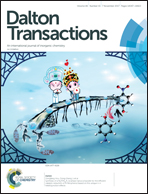Anticancer kiteplatin pyrophosphate derivatives show unexpected target selectivity for DNA†
Abstract
One of the promising new antitumor platinum complexes is a large-ring chelate complex [PtCl2(cis-1,4-DACH)] (DACH = diaminocyclohexane) (kiteplatin). Recently, new platinum(II) derivatives of kiteplatin with pyrophosphate as a carrier ligand have been synthesized and tested on a panel of human cancer cell lines. These derivatives of kiteplatin were found to be more effective than clinically used anticancer platinum drugs. The design of kiteplatin pyrophosphate derivatives was based on the concept of pyrophosphate coordinated platinum complexes, phosphaplatins. Phosphaplatins have been shown to function without binding to DNA and hence DNA has been excluded as the target of phosphaplatins in contrast to conventional antitumor platinum drugs. Cytotoxicity, major cellular targets and DNA interactions of the new anticancer platinum drug were characterized by standard biochemical methods and methods of molecular and cellular biology. We demonstrate that, in contrast to what has been reported on closely related phosphaplatins, the derivatives of kiteplatin with the pyrophosphate carrier ligand are activated in the cellular environment. This activation, which yields species capable of platination of DNA, very likely comprises the hydrolytic release of the pyrophosphate ligand that could be enzymatically catalyzed. Collectively, these data provide convincing evidence that unexpectedly DNA is an important target for the biological activity of the kiteplatin pyrophosphate derivatives, although the overall mechanism of action might be different from those of conventional platinum drugs.



 Please wait while we load your content...
Please wait while we load your content...